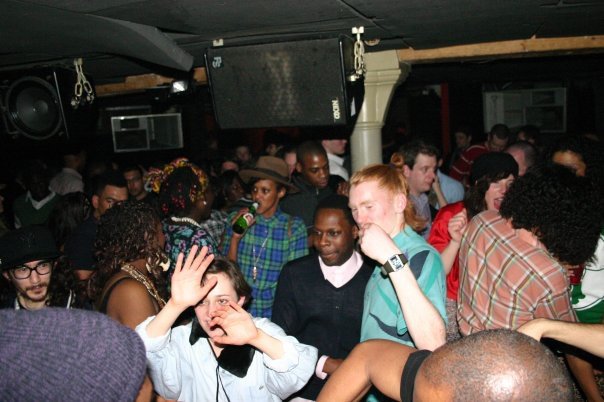Dubstep: what lies beyond? | reviews, news & interviews
Dubstep: what lies beyond?
Dubstep: what lies beyond?
How do you go beyond a genre without boundaries?
Dubstep is everywhere – and if you will excuse a little self-promotion I have, in my small way, helped this state of affairs come about. The bass-heavy, rhythmically exploratory and very British electronic dance music genre has now – via Magnetic Man and Katy B – proved it can produce bona fide top-10 hits, and it has become the de facto sound of every summer festival to boot, while still keeping both feet in the underground clubs from whence it emerged.
Watch the video of "Katy on a Mission" by Katy B:
Regular readers of theartsdesk will know that I have written extensively about the sound's cultural and artistic significance (here, here, here and here, for example); I have also covered it month-in month-out for some years in Mixmag and Wire magazines, and this week sees the release of a compilation that I curated on the huge Ministry of Sound label entitled Adventures in Dubstep and Beyond... Which, of course, begs the question: what is beyond dubstep?
 It's an oddly problematic question. Dubstep has a couple of peculiarities which make defining it, let alone predicting where it is going, difficult. Firstly, it is in the odd position of being a new sensation roughly a decade into its existence: the sound itself emerged in the south London suburb of Croydon some time around the turn of the millenium and the term “dubstep” was first used in 2003. Since then it has evolved and spread first slowly then exponentially, to the point now where a commercial dance label like Ministry simply cannot ignore it, and nor can radio programmers.
It's an oddly problematic question. Dubstep has a couple of peculiarities which make defining it, let alone predicting where it is going, difficult. Firstly, it is in the odd position of being a new sensation roughly a decade into its existence: the sound itself emerged in the south London suburb of Croydon some time around the turn of the millenium and the term “dubstep” was first used in 2003. Since then it has evolved and spread first slowly then exponentially, to the point now where a commercial dance label like Ministry simply cannot ignore it, and nor can radio programmers.
Until 2005, it was all but invisible, its fans and practitioners part of a hermetic underground of possibly only a few hundred people worldwide, then it burst onto the international stage, infiltrating first other underground scenes, then the wider world of youth culture, and finally in the last year or so the absolute heart of the mainstream. At every stage, naysayers predicted its demise or stagnation, but it has proved that its resilience and flexibility make it nothing if not unpredictable.
Second is its fecundity and its intrinsic hybrid nature. It is, as its 24-year-old figurehead and member of Magnetic Man Ollie Jones aka Skream (pictured below) says, “mongrel music”. From the very outset, it pilfered from all other club genres, and as it began to spread it then reached into and hybridised again with those genres, to the point where now across house, techno, drum and bass, trance and all the more 'traditional' club sounds, it's increasingly hard to find something that doesn't bear its sticky fingerprints, while dubstep itself no longer appears tethered to a particular tempo or rhythm, just a loose set of sonic signatures.
 So dubstep's borders are diffuse and permeable. But on my compilation, I have tried to demonstrate how many different sounds orbit the strange attractor of dubstep's distinctive basslines: on it there is blissed-out house music, but also furious grime MCing from London's estates, drifting tracks with thickly layered psychedelic detail, but also gung-ho, rough-and-ready rave tunes. Both of the tracks in the YouTube clips below, for example, feature on the album. Yet the progression of the tracks works to show how all are connected, even though any given two may appear to share almost no similar qualities. And what is “dubstep” and what is “beyond” its ruleset is as yet undetermined, and may become clear only in retrospect. Apologies if this seems a cop out, but in fact it is precisely this indeterminacy which makes the possibilities so thrilling. The sound's future is not written.
So dubstep's borders are diffuse and permeable. But on my compilation, I have tried to demonstrate how many different sounds orbit the strange attractor of dubstep's distinctive basslines: on it there is blissed-out house music, but also furious grime MCing from London's estates, drifting tracks with thickly layered psychedelic detail, but also gung-ho, rough-and-ready rave tunes. Both of the tracks in the YouTube clips below, for example, feature on the album. Yet the progression of the tracks works to show how all are connected, even though any given two may appear to share almost no similar qualities. And what is “dubstep” and what is “beyond” its ruleset is as yet undetermined, and may become clear only in retrospect. Apologies if this seems a cop out, but in fact it is precisely this indeterminacy which makes the possibilities so thrilling. The sound's future is not written.
It's a fascinating thing to behold the unfolding of this very 21st-century movement; something which is completely of the digital age, and doesn't adhere to the structural rules of the 20th-century youth revolutions of the summer of love, punk rock or acid house. As its mainstreaming accelerates there is a fear that it may become ossified into simplistic versions, its multivariant nature stifled – which is one reason I have compiled this mix: as an attempt to note and promote its mongrelism and blurred-edge zones. These are exciting times, and it is worth getting a taste of this music while it is still so insanely fertile.
Listen to "Back Again" by Kozzie:
Listen to "Natural Selection" by Martyn:
I am also moderating a panel discussion at the Are We Here arts festival in Croydon in November, with several generations of the borough's musicians discussing their roots and futures – of which more on theartsdesk anon.
Share this article
Add comment
The future of Arts Journalism
You can stop theartsdesk.com closing!
We urgently need financing to survive. Our fundraising drive has thus far raised £49,000 but we need to reach £100,000 or we will be forced to close. Please contribute here: https://gofund.me/c3f6033d
And if you can forward this information to anyone who might assist, we’d be grateful.

Subscribe to theartsdesk.com
Thank you for continuing to read our work on theartsdesk.com. For unlimited access to every article in its entirety, including our archive of more than 15,000 pieces, we're asking for £5 per month or £40 per year. We feel it's a very good deal, and hope you do too.
To take a subscription now simply click here.
And if you're looking for that extra gift for a friend or family member, why not treat them to a theartsdesk.com gift subscription?
more New music
 Doja Cat's 'Vie' starts well but soon tails off
While it contains a few goodies, much of the US star's latest album lacks oomph
Doja Cat's 'Vie' starts well but soon tails off
While it contains a few goodies, much of the US star's latest album lacks oomph
 Mariah Carey is still 'Here for It All' after an eight-year break
Schmaltz aplenty but also stunning musicianship from the enduring diva
Mariah Carey is still 'Here for It All' after an eight-year break
Schmaltz aplenty but also stunning musicianship from the enduring diva
 Album: Solar Eyes - Live Freaky! Die Freaky!
Psychedelic indie dance music with a twinkle in its eye
Album: Solar Eyes - Live Freaky! Die Freaky!
Psychedelic indie dance music with a twinkle in its eye
 Album: Night Tapes - portals//polarities
Estonian-voiced, London-based electro-popsters' debut album marks them as one to watch for
Album: Night Tapes - portals//polarities
Estonian-voiced, London-based electro-popsters' debut album marks them as one to watch for
 Album: Mulatu Astatke - Mulatu Plays Mulatu
An album full of life, coinciding with a 'farewell tour'
Album: Mulatu Astatke - Mulatu Plays Mulatu
An album full of life, coinciding with a 'farewell tour'
 Music Reissues Weekly: Sly and the Family Stone - The First Family: Live At Winchester Cathedral 1967
Must-have, first-ever release of the earliest document of the legendary soul outfit
Music Reissues Weekly: Sly and the Family Stone - The First Family: Live At Winchester Cathedral 1967
Must-have, first-ever release of the earliest document of the legendary soul outfit
 Album: Robert Plant - Saving Grace
Mellow delight from former Zep lead
Album: Robert Plant - Saving Grace
Mellow delight from former Zep lead
 Brìghde Chaimbeul, Round Chapel review - enchantment in East London
Inscrutable purveyor of experimental Celtic music summons creepiness and intensity
Brìghde Chaimbeul, Round Chapel review - enchantment in East London
Inscrutable purveyor of experimental Celtic music summons creepiness and intensity
 Album: NewDad - Altar
The hard-gigging trio yearns for old Ireland – and blasts music biz exploitation
Album: NewDad - Altar
The hard-gigging trio yearns for old Ireland – and blasts music biz exploitation
 First Person: Musician ALA.NI on how thoughts of empire and reparation influenced a song
She usually sings about affairs of the heart - 'TIEF' is different, explains the star
First Person: Musician ALA.NI on how thoughts of empire and reparation influenced a song
She usually sings about affairs of the heart - 'TIEF' is different, explains the star
 Album: The Divine Comedy - Rainy Sunday Afternoon
Neil Hannon takes stock, and the result will certainly keep his existing crowd happy
Album: The Divine Comedy - Rainy Sunday Afternoon
Neil Hannon takes stock, and the result will certainly keep his existing crowd happy
 Music Reissues Weekly: Robyn - Robyn 20th-Anniversary Edition
Landmark Swedish pop album hits shops one more time
Music Reissues Weekly: Robyn - Robyn 20th-Anniversary Edition
Landmark Swedish pop album hits shops one more time

Comments
...
...
...
...
...
...
...
...
...
...
...
...